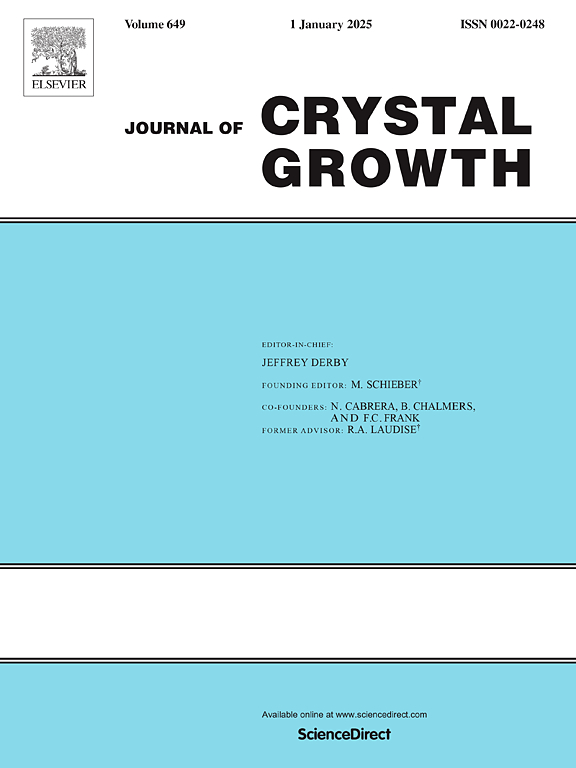一水胆固醇成核和生长的实时纳米级可视化
IF 2
4区 材料科学
Q3 CRYSTALLOGRAPHY
引用次数: 0
摘要
异常胆固醇结晶在许多疾病的发展中都有影响。然而,目前的成像方法依赖于大量的样品制备和静态条件,无法捕获实时转换。本研究利用原位石墨烯液体细胞透射电子显微镜捕捉一水胆固醇(ChM)成核和生长的纳米级事件。结果表明,ChM三斜型是通过非经典模式和经典模式的结合形成的,具体来说,是一种改进的Stranski - Krastanov机制。ChM三斜晶是由无定形前驱体形成的,该前驱体生长在三斜晶的表面上作为一层涂层。这些脱毛层结合成沿首选晶格平面形成的2D层,从而实现3D生长。分子动力学模拟表明,无定形到晶体的转变发生在由细丝连接的小簇的自组装中,这些小簇重新生长成具有暴露极性基团的双层。这些上层结构吸附在结晶胆固醇的表面,形成岛屿,岛屿扩散并形成新的双层核。这项研究强调了同外延在ChM生长中的重要性,并可能为生物学相关过程提供额外的见解,例如脂滴上的ChM成核。总的来说,本研究为在纳米尺度上实时研究ChM在溶液中的生长机制奠定了基础。本文章由计算机程序翻译,如有差异,请以英文原文为准。
Real-time nanoscale visualization of cholesterol monohydrate nucleation and growth
Aberrant cholesterol crystallization has implications in the development of numerous pathologies. However, current imaging methods rely on extensive sample preparation and static conditions, unable to capture real-time transformations. This study utilized in-situ graphene liquid cell transmission electron microscopy to capture nanoscale events of cholesterol monohydrate (ChM) nucleation and growth. The results revealed ChM triclinic forms through a combination of non-classical and classical modes, specifically, a modified Stranski − Krastanov mechanism. ChM triclinic nucleates from an amorphous precursor, which grows on triclinic surfaces as an epilayer. These epilayers coalesce into 2D layers formed along a preferred lattice plane, enabling 3D growth. Molecular dynamics simulations revealed that the amorphous to crystalline transition occurs via the self-assembly of small clusters, interconnected by filaments, which regrow into bilayers with exposed polar groups. These superstructures adsorb on the surfaces of crystalline cholesterol, form islands, which spread and form nuclei of a new bilayer. This study underscores the significance of homoepitaxy in ChM growth and may provide additional insights into biologically relevant processes, such as ChM nucleation on lipid droplets. Overall, this study lays the foundation for investigating the mechanisms of ChM growth from solution in real-time and on the nanoscale.
求助全文
通过发布文献求助,成功后即可免费获取论文全文。
去求助
来源期刊

Journal of Crystal Growth
化学-晶体学
CiteScore
3.60
自引率
11.10%
发文量
373
审稿时长
65 days
期刊介绍:
The journal offers a common reference and publication source for workers engaged in research on the experimental and theoretical aspects of crystal growth and its applications, e.g. in devices. Experimental and theoretical contributions are published in the following fields: theory of nucleation and growth, molecular kinetics and transport phenomena, crystallization in viscous media such as polymers and glasses; crystal growth of metals, minerals, semiconductors, superconductors, magnetics, inorganic, organic and biological substances in bulk or as thin films; molecular beam epitaxy, chemical vapor deposition, growth of III-V and II-VI and other semiconductors; characterization of single crystals by physical and chemical methods; apparatus, instrumentation and techniques for crystal growth, and purification methods; multilayer heterostructures and their characterisation with an emphasis on crystal growth and epitaxial aspects of electronic materials. A special feature of the journal is the periodic inclusion of proceedings of symposia and conferences on relevant aspects of crystal growth.
 求助内容:
求助内容: 应助结果提醒方式:
应助结果提醒方式:


